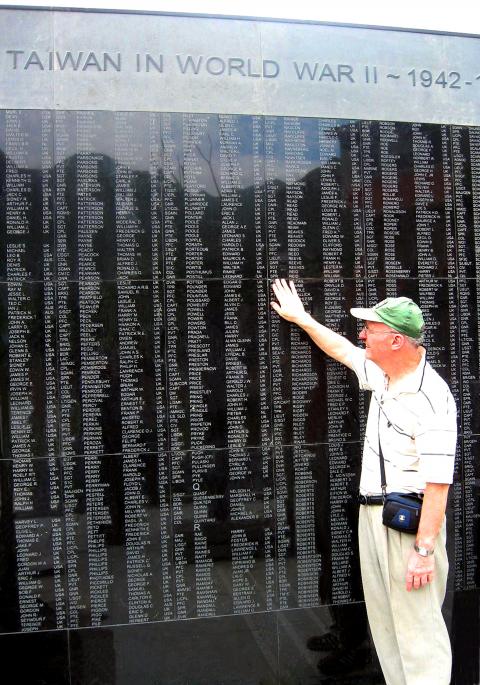The Taiwan Prisoners of War (POW) Camps Memorial Society, in cooperation with the Canadian Trade Office in Taipei, will unveil a 17m-long memorial wall on Sunday as part of its Remembrance Weekend, which commemorates Remembrance Day and pays tribute to Allied POWs imprisoned in Taiwan during World War II.
Ken Pett, a former Taiwan POW who last visited the country in 2009, several family members of POWs, diplomats and government officials will be on hand at the unveiling, society director Michael Hurst told the Taipei Times.
“There is the Vietnam [Veterans Memorial] Wall in Washington and the Wall [of Remembrance] for Korean veterans in Canada. But as far as I am aware, this wall is the only one of its kind dedicated solely to the Far East POWs [fighting in World War II], and it’s on the site of a former prison camp,” said Hurst, who has spent 15 years researching the history of Taiwan’s ex-POWs.

Photo courtesy of Taiwan POW Camps Memorial Society
Located in the Taiwan Prisoner of War Memorial Park at New Taipei City’s Jinguashih (金瓜石) near Jiufen (九份), the wall of polished black granite is inscribed with the names of the 4,363 former POWs who were imprisoned in often hellish conditions at 14 camps located throughout Taiwan during the Japanese colonial era.
Sundays’ dedication ceremony, which begins at 10am, will be followed by Remembrance Day services.
The society will also unveil a memorial today at the former site of Taihoku Camp No. 6, the Japanese Imperial Army’s main camp in Taipei from 1942 to 1945, which is now the recently completed headquarters for the Ministry of National Defense (MND).
Those wishing to attend today’s ceremony should gather at the corner of Beian Road (北安路) and Tongbei Street (通北街) near the Dazhi MRT Station (大直捷運站) at 1:30pm.
At 1:45pm, personnel from the MND will escort guests to the ceremony, which begins at 2pm.
Remarking on the significance of the memorial wall, Hurst said it is a testimony to the soldiers who fought during the war and the willingness of Taiwanese to remember one of the most dreadful periods in modern history.
“Just the fact that it is built here in Taiwan, which was on the other side so to speak, is an incredible thing in itself,” Hurst said. “And it shows the support of the Taiwan government at various levels, and the desire for Taiwanese to forgive and have lasting peace.”

June 23 to June 29 After capturing the walled city of Hsinchu on June 22, 1895, the Japanese hoped to quickly push south and seize control of Taiwan’s entire west coast — but their advance was stalled for more than a month. Not only did local Hakka fighters continue to cause them headaches, resistance forces even attempted to retake the city three times. “We had planned to occupy Anping (Tainan) and Takao (Kaohsiung) as soon as possible, but ever since we took Hsinchu, nearby bandits proclaiming to be ‘righteous people’ (義民) have been destroying train tracks and electrical cables, and gathering in villages

Dr. Y. Tony Yang, Associate Dean of Health Policy and Population Science at George Washington University, argued last week in a piece for the Taipei Times about former president Ma Ying-jeou (馬英九) leading a student delegation to the People’s Republic of China (PRC) that, “The real question is not whether Ma’s visit helps or hurts Taiwan — it is why Taiwan lacks a sophisticated, multi-track approach to one of the most complex geopolitical relationships in the world” (“Ma’s Visit, DPP’s Blind Spot,” June 18, page 8). Yang contends that the Democratic Progressive Party (DPP) has a blind spot: “By treating any

Swooping low over the banks of a Nile River tributary, an aid flight run by retired American military officers released a stream of food-stuffed sacks over a town emptied by fighting in South Sudan, a country wracked by conflict. Last week’s air drop was the latest in a controversial development — private contracting firms led by former US intelligence officers and military veterans delivering aid to some of the world’s deadliest conflict zones, in operations organized with governments that are combatants in the conflicts. The moves are roiling the global aid community, which warns of a more militarized, politicized and profit-seeking trend

This year will go down in the history books. Taiwan faces enormous turmoil and uncertainty in the coming months. Which political parties are in a good position to handle big changes? All of the main parties are beset with challenges. Taking stock, this column examined the Taiwan People’s Party (TPP) (“Huang Kuo-chang’s choking the life out of the TPP,” May 28, page 12), the Democratic Progressive Party (DPP) (“Challenges amid choppy waters for the DPP,” June 14, page 12) and the Chinese Nationalist Party (KMT) (“KMT struggles to seize opportunities as ‘interesting times’ loom,” June 20, page 11). Times like these can